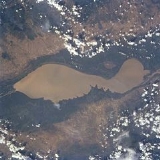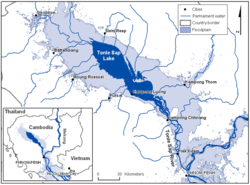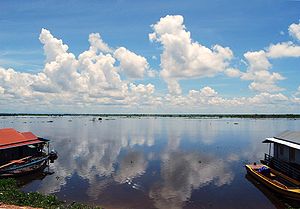
Tonlé Sap
Encyclopedia
The Tonlé Sap is a combined lake
and river
system of major importance to Cambodia
.
The Tonlé Sap is the largest freshwater lake in South East Asia and is an ecological hot spot that was designated as a UNESCO
biosphere in 1997.
The Tonlé Sap is unusual for two reasons: its flow changes direction twice a year, and the portion that forms the lake expands and shrinks dramatically with the seasons. From November to May, Cambodia's dry season, the Tonlé Sap drains into the Mekong
River at Phnom Penh
. However, when the year's heavy rains begin in June, the Tonlé Sap backs up to form an enormous lake.


season, however, the Tonlé Sap river, which connects the lake with the Mekong river, reverses its flow. Water is pushed up from the Mekong into the lake, increasing its area to 16,000 square km and its depth to up to nine meters, flooding nearby fields and forests. The floodplain provides a great breeding ground for fish
.
The pulsing system with its large floodplain
, rich biodiversity, and high annual sediment and nutrient fluxes from Mekong makes the Tonlé Sap one of the most productive inland fisheries in the world, supporting over three million people and providing over 75% of Cambodia's annual inland fish catch and 60% of Cambodians' protein
intake. At the end of the rainy season, the flow reverses and the fish are carried downriver.

. However, recent long-term sedimentation studies show that net sedimentation within the lake proper has been in the range of 0.1-0.16 mm/year since circa 5,500 years before present (BP) and hence there is no threat of the lake filling up with sediment. The nutrients bound to suspended sediments are important for the Tonle Sap system, particularly to maintain its long-term sustainability.
The reversal of the Tonlé Sap river's flow also acts as a safety valve to prevent flood
ing further downstream. During the dry season (December to April) the Tonlé Sap Lake provides around 50% of the flow to the Mekong Delta in Vietnam
.
The lake occupies a depression created due to the geological stress induced by the collision of the Indian subcontinent
with Asia
. In recent years, there have been concerns from scientists about the building of high dams and other changed hydrological parameters in Southern China and Laos that has threatened the strength and volume of the reverse flow into Tonle Sap, which in turn decreases nesting, breeding, spawning, and feeding habitats in floodplain, which results in adverse impacts on fish productivity and overall biodiversity.
. There are nine provinces that are part of the Tonle Sap Biosphere Reserve, these are; Banteay Meanchey, Battambang
, Kampong Chhnang, Kampong Thom, Preah Vihear, Pursat
, Siem Reap
, Otdar Meanchey, and Krong Pailin.
 The area is home to many ethnic Vietnamese
The area is home to many ethnic Vietnamese
and numerous Cham communities, living in floating villages around the lake.
Lake
A lake is a body of relatively still fresh or salt water of considerable size, localized in a basin, that is surrounded by land. Lakes are inland and not part of the ocean and therefore are distinct from lagoons, and are larger and deeper than ponds. Lakes can be contrasted with rivers or streams,...
and river
River
A river is a natural watercourse, usually freshwater, flowing towards an ocean, a lake, a sea, or another river. In a few cases, a river simply flows into the ground or dries up completely before reaching another body of water. Small rivers may also be called by several other names, including...
system of major importance to Cambodia
Cambodia
Cambodia , officially known as the Kingdom of Cambodia, is a country located in the southern portion of the Indochina Peninsula in Southeast Asia...
.
The Tonlé Sap is the largest freshwater lake in South East Asia and is an ecological hot spot that was designated as a UNESCO
UNESCO
The United Nations Educational, Scientific and Cultural Organization is a specialized agency of the United Nations...
biosphere in 1997.
The Tonlé Sap is unusual for two reasons: its flow changes direction twice a year, and the portion that forms the lake expands and shrinks dramatically with the seasons. From November to May, Cambodia's dry season, the Tonlé Sap drains into the Mekong
Mekong
The Mekong is a river that runs through China, Burma, Laos, Thailand, Cambodia and Vietnam. It is the world's 10th-longest river and the 7th-longest in Asia. Its estimated length is , and it drains an area of , discharging of water annually....
River at Phnom Penh
Phnom Penh
Phnom Penh is the capital and largest city of Cambodia. Located on the banks of the Mekong River, Phnom Penh has been the national capital since the French colonized Cambodia, and has grown to become the nation's center of economic and industrial activities, as well as the center of security,...
. However, when the year's heavy rains begin in June, the Tonlé Sap backs up to form an enormous lake.


Seasonal direction of flow
For most of the year the lake is fairly small, around one meter deep and with an area of 2,700 square km. During the monsoonMonsoon
Monsoon is traditionally defined as a seasonal reversing wind accompanied by corresponding changes in precipitation, but is now used to describe seasonal changes in atmospheric circulation and precipitation associated with the asymmetric heating of land and sea...
season, however, the Tonlé Sap river, which connects the lake with the Mekong river, reverses its flow. Water is pushed up from the Mekong into the lake, increasing its area to 16,000 square km and its depth to up to nine meters, flooding nearby fields and forests. The floodplain provides a great breeding ground for fish
Fish
Fish are a paraphyletic group of organisms that consist of all gill-bearing aquatic vertebrate animals that lack limbs with digits. Included in this definition are the living hagfish, lampreys, and cartilaginous and bony fish, as well as various extinct related groups...
.
The pulsing system with its large floodplain
Floodplain
A floodplain, or flood plain, is a flat or nearly flat land adjacent a stream or river that stretches from the banks of its channel to the base of the enclosing valley walls and experiences flooding during periods of high discharge...
, rich biodiversity, and high annual sediment and nutrient fluxes from Mekong makes the Tonlé Sap one of the most productive inland fisheries in the world, supporting over three million people and providing over 75% of Cambodia's annual inland fish catch and 60% of Cambodians' protein
Protein
Proteins are biochemical compounds consisting of one or more polypeptides typically folded into a globular or fibrous form, facilitating a biological function. A polypeptide is a single linear polymer chain of amino acids bonded together by peptide bonds between the carboxyl and amino groups of...
intake. At the end of the rainy season, the flow reverses and the fish are carried downriver.

Sedimentation
National and local observers often state that the Tonlé Sap Lake is rapidly filling with sedimentSediment
Sediment is naturally occurring material that is broken down by processes of weathering and erosion, and is subsequently transported by the action of fluids such as wind, water, or ice, and/or by the force of gravity acting on the particle itself....
. However, recent long-term sedimentation studies show that net sedimentation within the lake proper has been in the range of 0.1-0.16 mm/year since circa 5,500 years before present (BP) and hence there is no threat of the lake filling up with sediment. The nutrients bound to suspended sediments are important for the Tonle Sap system, particularly to maintain its long-term sustainability.
The reversal of the Tonlé Sap river's flow also acts as a safety valve to prevent flood
Flood
A flood is an overflow of an expanse of water that submerges land. The EU Floods directive defines a flood as a temporary covering by water of land not normally covered by water...
ing further downstream. During the dry season (December to April) the Tonlé Sap Lake provides around 50% of the flow to the Mekong Delta in Vietnam
Vietnam
Vietnam – sometimes spelled Viet Nam , officially the Socialist Republic of Vietnam – is the easternmost country on the Indochina Peninsula in Southeast Asia. It is bordered by China to the north, Laos to the northwest, Cambodia to the southwest, and the South China Sea –...
.
The lake occupies a depression created due to the geological stress induced by the collision of the Indian subcontinent
Indian subcontinent
The Indian subcontinent, also Indian Subcontinent, Indo-Pak Subcontinent or South Asian Subcontinent is a region of the Asian continent on the Indian tectonic plate from the Hindu Kush or Hindu Koh, Himalayas and including the Kuen Lun and Karakoram ranges, forming a land mass which extends...
with Asia
Asia
Asia is the world's largest and most populous continent, located primarily in the eastern and northern hemispheres. It covers 8.7% of the Earth's total surface area and with approximately 3.879 billion people, it hosts 60% of the world's current human population...
. In recent years, there have been concerns from scientists about the building of high dams and other changed hydrological parameters in Southern China and Laos that has threatened the strength and volume of the reverse flow into Tonle Sap, which in turn decreases nesting, breeding, spawning, and feeding habitats in floodplain, which results in adverse impacts on fish productivity and overall biodiversity.
Biosphere reserve
The Tonle Sap Lake and its surrounding provinces are part of the Tonle Sap Biosphere ReserveTonle Sap Biosphere Reserve
The Tonle Sap Biosphere Reserve is a unique ecological phenomenon surrounding the Tonle Sap or Great Lake of Cambodia. In 1997, it was successfully nominated as a UNESCO Biosphere Reserve.-Tonle Sap:...
. There are nine provinces that are part of the Tonle Sap Biosphere Reserve, these are; Banteay Meanchey, Battambang
Battambang
Battambang is the capital city of Battambang province in northwestern Cambodia.Battambang is the second-largest city in Cambodia with a population of over 250,000. Founded in the 11th century by the Khmer Empire, Battambang is well known for being the leading rice-producing province of the country...
, Kampong Chhnang, Kampong Thom, Preah Vihear, Pursat
Pursat
Pursat is the capital of Pursat Province, Cambodia. Its name derived from a type of tree.- Notes :...
, Siem Reap
Siem Reap
Siem Reap is the capital city of Siem Reap Province in northwestern Cambodia, and is the gateway to Angkor region.Siem Reap has colonial and Chinese-style architecture in the Old French Quarter, and around the Old Market...
, Otdar Meanchey, and Krong Pailin.
People and culture

Vietnamese people
The Vietnamese people are an ethnic group originating from present-day northern Vietnam and southern China. They are the majority ethnic group of Vietnam, comprising 86% of the population as of the 1999 census, and are officially known as Kinh to distinguish them from other ethnic groups in Vietnam...
and numerous Cham communities, living in floating villages around the lake.
Further Reading
- Milton OsborneMilton OsborneMilton Osborne is an Australian historian, author, and consultant specializing in Southeast Asia.He attended North Sydney Boys High School, graduated from the University of Sydney and received a Ph.D. from Cornell University. Osborne held academic positions in Australia, the United Kingdom, the...
, The Mekong, Turbulent Past, Uncertain Future (Atlantic Monthly Press, 2000) ISBN 0871138069
External links
- Tonle Sap Biosphere Reserve : Environmental Information Database
- THE STRATEGIC SIGNIFICANCE OF THE MEKONG By: Osborne, Milton
- Washington Post
- Country Profile
- International Journal of Water Resources Development - Tonle Sap Special Issue
- Tonle Sap Modelling project (WUP-FIN) under Mekong River Commission
- Protected areas in Cambodia

